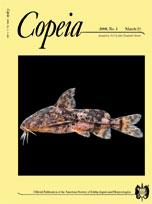We used 991 bp of mtDNA (D-loop/ND4L/ND4) and eight microsatellite loci to examine population structure and genetic diversity of Catostomus plebeius from nine localities across the northern part of its range in New Mexico. Two phylogeographic regions (Mimbres and Rio Grande) were defined by phylogenetically distinct collections of mtDNA haplotypes. Mismatch distribution analysis and relatively deep coalescence of haplotypes within the upper Rio Grande suggested rapid population expansion of Rio Grande populations following putative colonization from the ancestral Cabeza de Vaca lake system during the Miocene. Mitochondrial haplotypes indicated that individuals from Palomas Creek (near present-day Elephant Butte Reservoir) shared most recent common ancestry with the Rio Grande phylogeographic region. Microsatellite diversity and allele identity supported the hypothesis of native status of C. plebeius from Sapillo Creek in the Gila River drainage. Analysis of molecular variance within and among samples from the upper Rio Grande suggested low levels of historic gene flow across that basin, with ΦST = 0.19 and FST = 0.14 for mtDNA and microsatellites, respectively.
Utilizamos marcadores mitocondriales (991 bp) y ocho microsatélites (DNA) para examinar la diversidad y la estructura genética de poblaciones de Catostomus plebeius en nueve localidades en Nuevo México. Se identificaron dos regiones filogeográficas distintas: el Mimbres (Río Mimbres y Sapillo Creek) y el Río Grande (Palomas Creek y localidades a lo largo del Río Grande). El análisis demográfico mitocondrial permitió discernir una estabilidad histórica en la población del Río Mimbres, así como una expansión de poblaciones en el Río Grande después de la colonización del lago Cabeza de Vaca a partir del Plioceno Tardío. Datos genéticos sugieron que la población en Palomas Creek (cercano Elephant Butte Reservoir) es relacionado a las poblaciones in el Río Grande. Un alto número alelos únicos en los microsatélites encontrados en Sapillo Creek (un tributario del Río Gila), sugiere que la población es nativa y que pudo haber colonizado el área durante un proceso de captura de un tributario del Río Mimbres. Encontramos una estructura genética de moderada a fuerte en el mitocondrial y microsatélite DNA entre los tributarios superiores del Río Grande, con ΦST = 0.19 y FST = 0.14, respectivamente.





